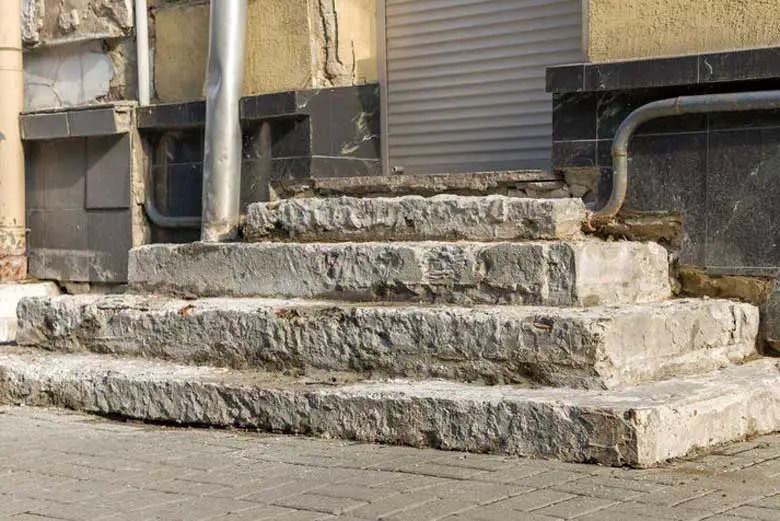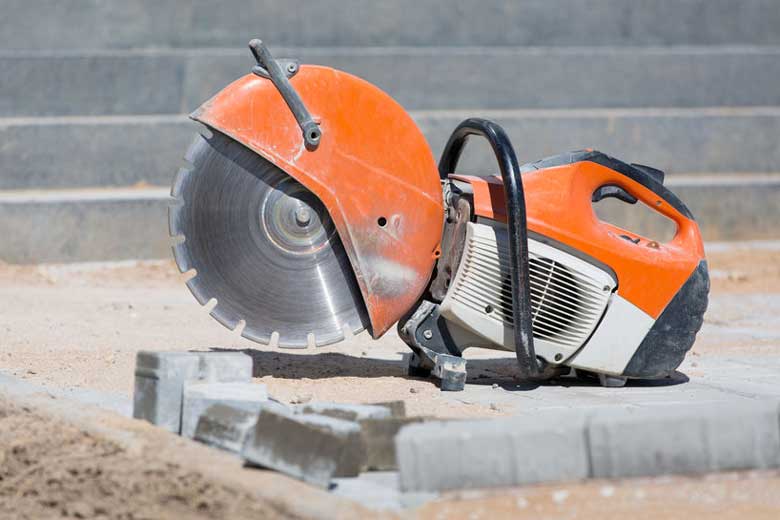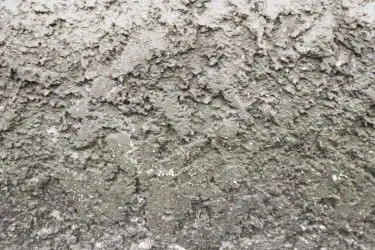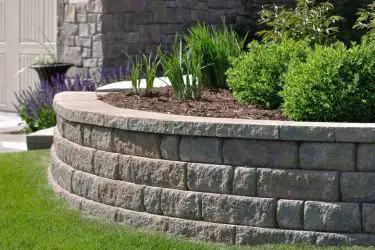Concrete is an excellent choice when looking to install durable and long-lasting steps to your home or new building project. However, removing concrete steps is not an easy process and will take some time and effort.
To break up concrete steps, always be sure that there are no utility lines or pipes in the area and wear the proper safety gear. Determine if your steps are solid concrete or poured over a foundation and break into chunks using a jackhammer, sledgehammer, circular saw, or concrete chisel.
This article will explore the initial steps you need to take before starting demolition on concrete steps and what safety measures are worth considering. We’ll then discuss the best ways to break up concrete steps, including handling steel reinforcements such as wire mesh.

Table of Contents
Analyze the Foundation’s Structure
When looking to break up concrete steps for home renovation or possible demolition, it is vital to check the foundation first.
In some older houses, though not common, concrete steps may have been poured at the same time as the house’s foundation. If this is the case, the concrete steps will be firmly connected to the house, and you will need to carefully detach the steps to prevent damage to the house foundation.
Before you break up and remove such steps, it might be worth considering repairing the steps instead. We wrote an article to guide you through the process of repairing concrete steps the right way, which you could check out before you proceed.
To remove steps from an existing foundation, begin by creating cuts on the surface eight to ten inches away from the house. Then cut as close to the foundation as possible, working parallel to the first cut. Using a pry bar, stamp on the space between the cuts and remove the pieces that crack away.
This can be done along the length of the steps, exposing the house’s foundation line. Continue with breaking down the steps, avoiding using a jackhammer on the line closest to the home. A handheld drill or chisel can be used to remove leftover concrete on the house.
How Are Concrete Steps Installed?
However, it is not common to see concrete steps attached to a house in this way. The most common way concrete steps are installed is by creating a form on a foundation.
- Excavate the area, digging deeper than the frost line.
- Fill the space with crushed stone and gravel to allow for drainage.
- Put in a concrete form (wood bracing frame) the size of the foundation.
- Ensure there are adequate reinforcement spikes that are raised higher than the gravel level.
- Attach rebar to the reinforcement spikes and pour the concrete foundation.
- Smooth the foundation and leave the dry at least overnight.
- Attach the concrete form for the steps.
- Attach rebar and wire mesh for support.
- Pour the concrete and smooth it out.
- Allow to set and remove the form.
In some cases, extra gravel and sand will be used to fill some forms, preventing extra concrete. This needs to be packed down tightly to act as a base. You can also use rubble to fill the space further, lowering the cost of the concrete. In this instance, the rubble should not come up too high, and rebar needs to be installed on top.
For shallow steps, such as those often found on a low incline, tightly packed gravel and sand are strong enough to build a foundation. A form can be erected in longer strips, creating shallow stairs that do not require the same solid foundation as mentioned above.
Some older steps may have been erected using concrete blocks cemented together. This is a faster and inexpensive way to create a set of steps and is relatively easy to remove.
In recent years, precast concrete steps have become quite popular. They can be bought in single steps, or as whole staircases. A foundation is needed in the same way as the above method, and the steps are brought in ready-made and installed without the need for step forming and bracing.
Why the Foundation Matters
If your concrete steps were poured onto a separate foundation, they would be far easier to break up. Similarly, if they were poured over a gravel and rubble foundation, the work to break the concrete will be much quicker than solid concrete. Either way, they will more than likely be reinforcements inside the concrete that will need to be broken down will wire cutters and saws.
Breaking concrete steps that have been made out of blocks will involve digging into the cement sealant to loosen the bricks. In some cases, the bricks may have been filled with gravel to weigh them down and keep the structure in place.
Precast steps can come in single slabs placed on top of each other or in finished units, which are typically hollow. Due to their shaping technique, the steps can be poured and cured in thinner shapes, preventing the need for excess concrete.
Unlike traditionally poured steps, they are cured until solid within a mold and released into the step shape. Precast steps can often be removed in one piece using a crane and require no demolition at all.
Follow These Safety Tips
Before you begin any construction work, it is critical to ensure you have all the correct equipment and safety gear and that the area is safe for you to work on. Some key things to consider include:
- Always wear safety goggles and earplugs when operating heavy equipment.
- Wear steel-toed boots.
- Always use the proper equipment for the job at hand.
- If working with a jackhammer, be mindful of the house’s foundation.
- Check with the city for pipes or electrical lines that may be beneath the ground.
- Older steps may have steel handrails that sit deep inside the concrete.
- Look at options for how best to remove concrete once it has been broken.
- Use a backhoe or front loader for removing larger pieces.
Always Wear Safety Gear
Goggles, gloves, and earplugs are essential when working with power tools or heavy machinery. There will be hazardous dust and broken fragments that may be launched into the air when using a sledgehammer or jackhammer in breaking down concrete. Thick gloves are recommended to handle chunks of concrete and steel toe boots to protect feet and toes from falling debris.
Consider wearing heavy, thick clothing as well to protect your arms and legs from flying debris, and lay down sheets to prevent it from striking windows or nearby structures.
When pounding into concrete with a hammer, it is not uncommon to see shards fly off the concrete. These can cause serious injury if your arms and legs are uncovered and can scratch house and car windows.
Use the Proper Equipment
One one the fastest ways to break up concrete is with a jackhammer. However, it is possible to do it by hand. In this case, having the right equipment is crucial. This will include:
- A sledgehammer to break apart the concrete
- A pry bar to lift and pry any larger pieces apart
- A durable shovel to dig into the ground beneath to allow for better access
- Wire cutters to cut wire support mesh
- A reciprocating saw or angle grinder to cut through steel bars
- A heavy mattock to pull apart large chunks
- Garden hose to wet the surface and reduce dust
If you are unfamiliar or unsure, call a professional before working with heavy equipment. Always wear the appropriate safety gear and ensure the area is clear before starting work on the concrete. Begin near the edges, creating cracks in the surface that can be pulled apart for removal.
Call Your Utility Company To Check for Lines
From gas lines to electrical lines, it is critical to ensure you are not working on an area of ground that could result in your injury or damage to existing utility lines. You can check this by calling local utility companies or your local government office. If you find that there are lines near the worksite, it is recommended to hire a professional. Digging and working above gas or electrical lines is extremely dangerous and requires professional knowledge.
Cut the Steel Bars To Remove Steel Handrails
Some older concrete steps may have steel handrails inserted into the concrete at the original pour time. If this is the case, the steel may sit deep in the concrete, and you may need to cut the bars to remove it safely. When working to break the concrete, be sure to give the steel a wide berth to prevent contact with a sledge or jackhammer.
Remove Broken Concrete
Always wear heavy gloves when working with broken pieces of concrete. There will be wire mesh and steel bars inside the concrete in many cases, acting as support that can easily break during demolition and create a hazard within the rubble. Depending on the chunks’ size, you may need to hire a backhoe to lift larger pieces away from the site safely.
Breaking Up Concrete Steps With a Jackhammer
When using a jackhammer, the goal is to crack the concrete into manageable-size chunks. It is not a good idea to completely pulverize the slab, as this would take too much time. The only reason you may choose to work the concrete into small pieces is if you are looking to use the concrete as filler for another project.

Depending on the location of your steps, and the proximity to windows, cars, and fences, you should lay down a protective sheet to prevent dust and shards of concrete from causing damage. Windows can be covered in a tarp, and cars should be moved out of the demolition area.
How to break up concrete steps with a jackhammer:
- Be sure to have all the equipment ready to go.
- Wear the appropriate safety gear, such as goggles and boots.
- Start jackhammering on the top step near the edge or corner.
- A crack should appear in the step, moving from the point of impact.
- Step back, bringing the jackhammer away from the break but still need the edge.
- Jackhammer the new spot until you see a new crack.
- Repeat this process until the step is cracked across the whole surface.
- Carefully remove chunks of concrete.
- Use a sledgehammer or pry bar to break off any pieces that are not fully detached.
- Working your way down, repeat this step by step until you reach the bottom.
Remember to use a chisel bit and always allow the machine’s weight to break up the concrete. There is no need to push it down when working, which can cause the tool to get stuck.
If the concrete does not crack when you begin jackhammering, stop working in that spot and move a few inches away. Continued hammering could break the tool and get the drill bit stuck.
Breaking Up Concrete Steps Without a Jackhammer
In some cases, it is not possible or necessary to hire a jackhammer. The steps may be small, or you may not have access to such heavy equipment. To break up concrete steps without a jackhammer, you will need to work the concrete in a few ways:
- Use a saw to cut into the concrete, creating fractures to break with a hammer or pry bar.
- Drill holes into the concrete to create weak spots that can be hammered into removable chunks.
- Use a sledgehammer to work from the edges inward, breaking the concrete into chunks.
To determine if you’re working with precast steps, concrete over gravel foundation, concrete blocks, or solid poured concrete, take a sledgehammer to a top edge and break away concrete until you either see the foundation or not. You may see the brickwork on the side with concrete blocks, though some people will cover that with excess cement or paint. A sledgehammer will free any surface cement to show the brick behind.
In the case of precast, you should see a hollow gap once you break through the concrete. Concrete over foundation will eventually give way to sand, gravel, and rubble. However, if you work on a corner more than ten inches deep and find no evidence of foundation, chances are you have a solid pour of concrete.
Removing precast steps will be the most straightforward job and can be done in a couple of hours by a professional. These steps will be lifted out whole by a crane and taken for recycling by the company. However, if you choose to demo the steps yourself, their hollow design will make it much quicker.
Breaking Up Concrete Steps Using a Circular Saw
A concrete or demolition saw is a type of circular saw with a heavy-duty blade designed to cut through durable concrete. They can be bought and rented from most hardware stores and will make the job of breaking up concrete much quicker.

When using a circular saw to cut your concrete, keep in mind the following:
- Do not push on the blade to make a deeper cut. The weight of the machine should be enough to force the edge into the surface gently.
- Dry cutting can cause blades to overheat. Always pull the edge free, letting it run for 30 seconds to cool before continuing with the work.
- Always wear safety gear when using a circular saw. This will include eye protection, a dust mask, earplugs, and heavy gloves.
Before you begin cutting, if possible, determine how deep the concrete is. If you have a solid block, you will need to cut into the concrete and work down, removing layers as you go. However, if you have thinner concrete over a foundation, you should be able to cut deep enough to make clean cuts all the way through.
Related article: Using a Concrete Saw to Cut Through Rebar
How to break concrete steps with a circular saw:
- Begin on the top step, marking lines with chalk.
- Mark the lines eight to ten inches apart, running along the length of the step.
- Make your cuts, work slowly across the surface, and use water if necessary to avoid excessive dust clouds.
- Using a pry bar, hit the space between the cuts to create a crack between the lines.
- Pry the chunks away, removing loose concrete as you go.
When working on thicker or solid pieces of poured concrete, you will need to cut the lines and use the pry bar to break chunks. Unlike thinner areas which should come away in bricks, you will likely see uneven pieces break free. In this case, you may need to strike the area with a sledgehammer to loosen the chunks. Remove the top layer and repeat the process, moving down as you work.
You will need to buy one of three blades that are strong enough to cut through concrete:
Abrasive Corundum Masonry Blades
Abrasive corundum masonry blades are readily available in most DIY stores and are typically used for cutting concrete, asphalt, and stucco.
Though they are inexpensive, they will only cut shallow grooves, making the work time-consuming.
These blades are a good option if you have a set of small, shallow steps, as they wear quickly and will not hold up to a larger project.
However, they are known to overheat and create clouds of dust.
Dry-Cutting Diamond Blades
Diamond blades are made up of a metal blade with a diamond and metal composite layer bonded to the edge. As the blade is used, the metal composite will begin to wear, revealing the sharp diamond cutting edge.
They are more expensive than typical abrasive blades but will last much longer.
Dry-cutting diamond blades have a serrated edge to keep the blade cool and remove small particles of dirt and rubble as it spins. Best used in gradual cuts, working deeper on each pass, these are also known to create a lot of dust.
Wet-Cutting Diamond Blades
Wet-cutting diamond blades may have a serrated or a smooth edge. With this saw, water is used to keep the blade cool and prevent high dust levels from becoming airborne.
They are the fastest and cleanest option but cannot be used on a standard saw. They require a special machine that can distribute water.
If you notice your diamond blade is not cutting, it means that your surface is too soft. These blades require a more rigid surface to wear down the metal composite to reveal the diamond edge.
Related article: Can You Cut Concrete With a Sawzall?
Breaking Up Concrete Steps Using a Sledgehammer

Using a sledgehammer is good practice for a small set of steps or steps you know to be built upon a foundation. The reason being that a solid area of concrete will be incredibly difficult and time-consuming to break by hand.
How to break up your concrete steps with a sledgehammer:
- Lay thick plastic over the area to prevent excessive dust and debris.
- Begin on the top corner, working inward until you have the top layer broken.
- Allow the sledgehammer to fall, using gravity as a force rather than slamming it to the ground.
- Clear the debris and continue working down.
If you find that the concrete steps have been poured into a solid form, you may need to use a saw or jackhammer to work the bulk of the concrete free. Be sure to use a pry bar to remove chunks, and a chisel can also be used to create weak spots in the concrete.
If you encounter steel bars or wire mesh, work the concrete away from the metal as much as possible before using a saw or wire cutters to remove the pieces. You may need to chisel around the steel bars in some areas.
Related article: Can You Use a Pickaxe To Break Concrete?
Breaking Up Concrete Steps Using a Drill/Chisel

It is possible to use a handheld hammer drill or concrete chisel to create weak concrete spots. Unlike the circular saw, you will not be able to cut a clean line into the surface, but you will be able to make cracks that can be pried apart with a pry bar or broken with a sledgehammer.
Here’s how to use a drill/chisel to break up concrete steps:
- Using a small chisel, mark a shallow line on the surface to act as a guide for your drill bit or chisel.
- Working in small sections, apply the drill/chisel and create cracks in the concrete’s surface.
- Remove loose chunks and pry larger pieces free from the rest of the steps.
With this kind of tool, it is possible to make a crack along the length of the step and the base, creating a large portion of concrete that can be pried free. Using a pry bar, tap down in the center to break the piece in half and remove it in a brick shape.
A drill or chisel is also the best tool to use for removing concrete blocks. In this case, you can work at the sealant between the blocks to loosen the cement.
Once cracked, the bricks will pull away quite quickly and with minimal effort. You may need to use a pry bar for heavier blocks to loosen the bricks and move them freely.
Removing Concrete Step Reinforcements
The vast majority of concrete structures contain some kind of steel reinforcement. This could be steel mesh or rebar laid out throughout the slabs. When creating concrete steps, it is typical practice to line the foundation or top layer of concrete with such reinforcement to make the concrete more durable.
When connecting concrete steps to an existing foundation (house foundation), it is recommended to drill rebar into the house and attach new bars to this, which span the area of the steps. In other cases, there will likely be rebar within the foundation of the steps, used to keep them grounded and secure.
Rebar and wire mesh are used to secure concrete steps both to the ground and house and prevent the steps from cracking. Making the steps completely secure and unmoving will help prevent movement and cracks from forming. Such gaps can form over years of continued use or in the event of a rainstorm soaking the settlement around the foundation.
Wire Mesh Removal
Wire mesh is often used to prevent cracking in the concrete due to movement. If you encounter wire mesh during your demolition, the best way to remove it is to break as much concrete off the mesh as possible with a sledgehammer or pry bar.
Once the mesh is as free from concrete as possible, use a heavy-duty wire cutter to cut accessible portions as you work.
It is best practice to cut smaller portions as they become exposed rather than expose larger pieces. This is due to ease of access and safety.
Be careful of sharp ends as you continue to work, and always work from one edge to another.
Steel Bar Removal
More significant concrete steps and those that span a more extended length will almost certainly contain steel bars for support. These are often attached to bars in the ground and worked into a grid covering the foundation area of the stairs.
To remove rebar from your concrete steps, try to determine if there is a pattern or grid shape. If this is the case, you can aim your jackhammer or sledgehammer into the middle of the squares, loosening the concrete without hitting the steel. Use a hammer or pry bar to get as close to the steel as possible.
Once you have the steel exposed, cut with an angle grinder or a circular saw.
Final Thoughts
Breaking up concrete steps can be done in a few ways, depending on the type of concrete in the space. Concrete blocks and shallow steps will easily be broken with a sledgehammer or chisel and removed without the need for a jackhammer. However, you will need a jackhammer to reduce the workload for poured concrete steps that are heavy and thick.



